Case Study: Oil & Gas, Midstream
API 692 Gas Panel Upgrade

Equipment: Propane Compressor
Application: Propane Service
Pressure: Ambient
Pressure: P1: Propane Inlet – 80 psig
Nitrogen (N2) Sweep – 80 psig, regulated down to 12 psig
N2 Inlet for start-up – 375 psig
Product: Propane Lean Gas
Facility: Midstream Gas Pipeline Station
Industry: Oil & Gas, Midstream
Introduction
A leading provider of midstream services and one of the largest independent midstream infrastructure companies in North America recently reached out to Flexaseal for assistance in improving their gas control panels on a pipeline gas compressor installation. This end user operates a diversified portfolio of assets that efficiently supply natural gas and NGLs to both domestic and international markets. In the midstream sector of the oil and gas industry, compressors are a critical component of rotating equipment asset management and operational reliability, where minimizing downtime is essential to avoid significant production and cost impacts.
Dry gas seals (DGS) are the latest technology used in compressors and require clean gas to function effectively, ensuring long-term reliability and increased mean time between failures (MTBF). To achieve this, gas conditioning skids or gas panels are implemented alongside dry gas seals to condition, monitor, and treat process gas before it is injected into the primary seals. This underscores the importance of gas panels in compressor service and the end user’s urgency to repair them promptly to ensure the availability of propane compressors in the field.
The Challenge
The customer needed a retrofit and overhaul of three gas conditioning panels, where system conditions had significantly deteriorated due to corrosion and routine wear and tear. The primary challenges included a lack of documentation, inconsistent designs between the three installed panels, missing components, and long lead times for routine service parts.
The Solution
The first step in rebuilding the panels involved reviewing industry standards for gas conditioning units, such as API 692 (Dry Gas Sealing Systems for Axial Centrifugal Rotary Screw Compressors and Expanders), to ensure proper panel functioning. A new P&ID was created, following the original panel layout and using API 692 as a guideline. The panel was divided into four modules:
- Alternate Seal Gas
- Filters
- Differential Seal Gas Supply Pressure Control
- Separation Gas Supply Control and Primary Vent
The alternate seal gas module consisted of the propane source gas from the compressor discharge or alternate seal gas supply (nitrogen), which passed through filters and a bypass arrangement to remove particles. It then went through a differential pressure control module, supplying seal gas above a referenced sealing pressure line to prevent reverse pressure of unfiltered process gas across the inner labyrinth seal and into the gas seal.
Additionally, the panels included a separation gas supply (nitrogen) to the barrier seal, preventing lube oil migration into the gas seal. The panels also featured a primary gas seal vent, typically connected to the user’s flare system, to safely vent gas seal leakage from the primary seal.
After understanding the panel’s functioning, a bill of materials was created using the same brands and model numbers from the original panel to order equivalent parts, including tubing, compression fittings, valves, and instrumentation. Everything was labeled and photographed before disassembly to provide a visual reference during reconstruction. The stainless-steel cabinet was reused to maintain the same dimensions and layout. Connection and instrument tags were retained to avoid field confusion. New valve tags were added, using correlative numbers based on module location and valve type, enabling quick identification and communication for part orders.
To mitigate long lead times for components, some old equipment was used during construction to design the tubing architecture and maintain dimensional tolerances. Once new parts arrived, they replaced the old ones. Refurbished P&IDs were laser-etched and installed inside the panel, with all components wire-tagged for quick field reference. Stickers with flow orientation were added to the tubing, using different colors to distinguish propane and nitrogen lines.

The Result
Flexaseal supplied a completely refurbished panel complete with new tubing, fittings, instruments, and valves on a very short timetable to meet the customer’s needs. The panel was tested with nitrogen in our test facility in Houston, and confirmed zero detectable leakage on the tubing and fitting connections. Pressure limiting valves, relief valves, regulators, and instruments were also tested and verified to be in good working order.
The panel was delivered to the customer and on-site training and process operational checks conducted. The customer was very pleased with both the responsiveness, quality of work, and final product from Flexaseal’s system division in Houston.

The Conclusion
The customer was extremely satisfied with their new panel, especially with the care taken to ensure ease of operation and future serviceability. The opportunity cost of having their propane compressor out of service made the upgrade and refurbishment by Flexaseal imperative. Additionally, the end-user was impressed by the enhancements provided by Flexaseal:
- Simplified flow paths and tubing arrangements
- Laser-etched P&ID’s in the panel door
- Descriptive and illustrated tagging
- Flow direction indicators
Flexaseal stands ready to assist this and future customers with their API 692 conforming gas control panel needs.
